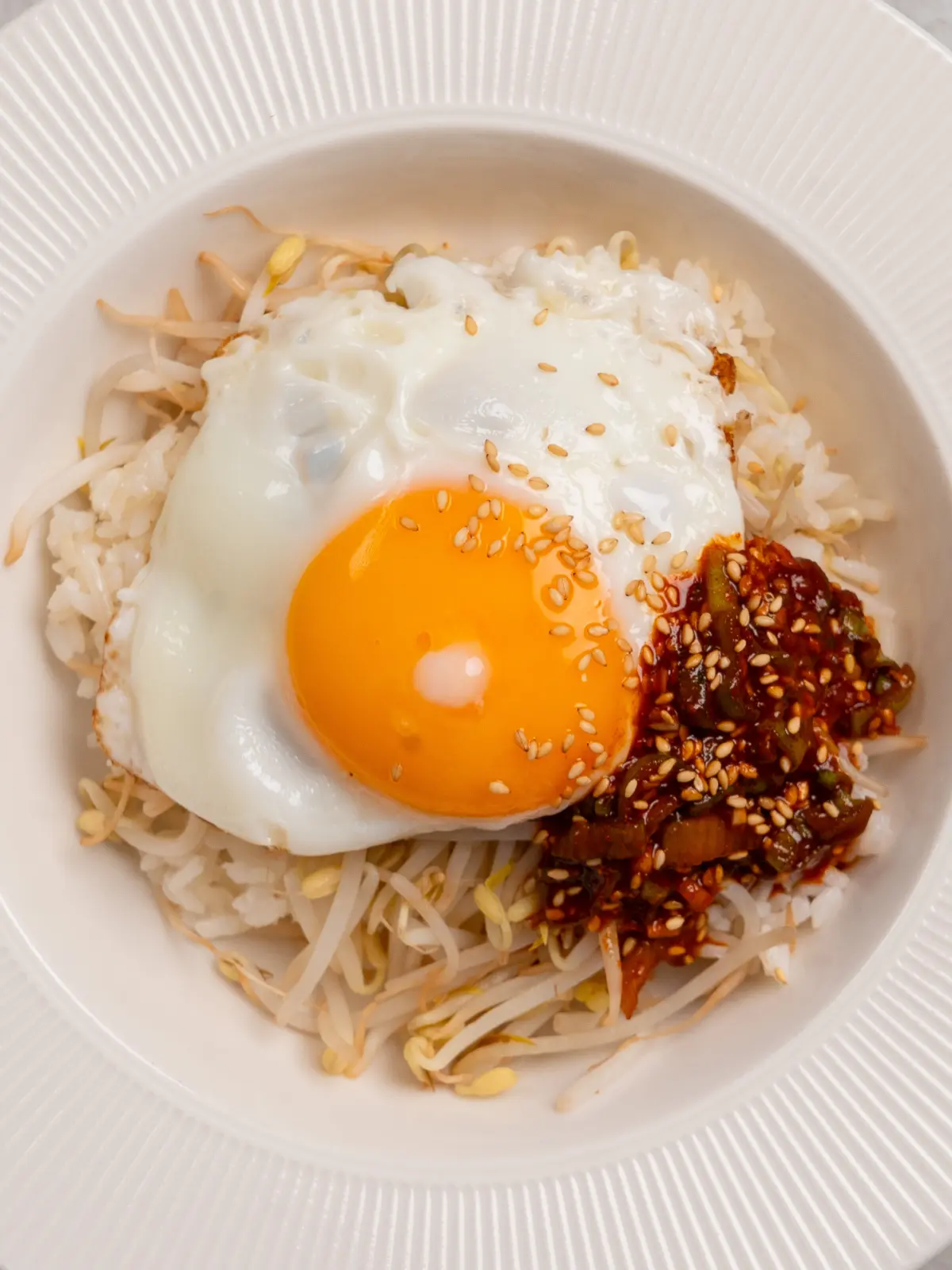This is a 5-minute microwave version of kongnamul bibimbap, which is Korean soybean sprout bibimbap!
Have you loved bibimbap but felt it was too much effort because there were so many ingredients? This sprout bibimbap is super simple! And for those who found gochujang too spicy, you’re going to love this authentic Korean bibimbap. This version uses a soy-based sauce instead of gochujang. Take one bite and your eyes will pop wide—you’re in for an amazing taste experience.
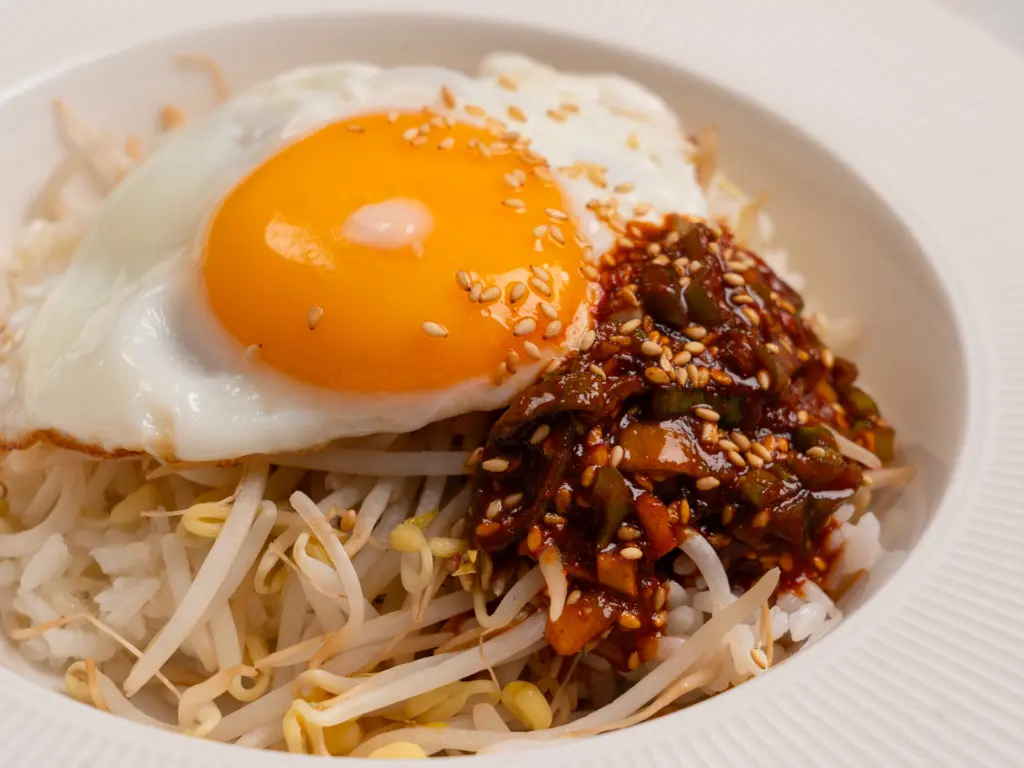
Table of Contents
What is Kongnamul Bibimbap? 콩나물 비빔밥
Kongnamul Bibimbap is a Korean rice dish featuring soybean sprouts (콩나물, kongnamul) as the main ingredient. Unlike common restaurant style bibimbap, which often uses gochujang (Korean chili paste) for seasoning, this dish employs a soy-based sauce, offering a milder and more savory flavor profile. The combination of nutty soybean sprouts, warm rice, and a fried egg provides a balanced and satisfying meal. It’s a perfect choice for those seeking a lighter alternative to the classic bibimbap.
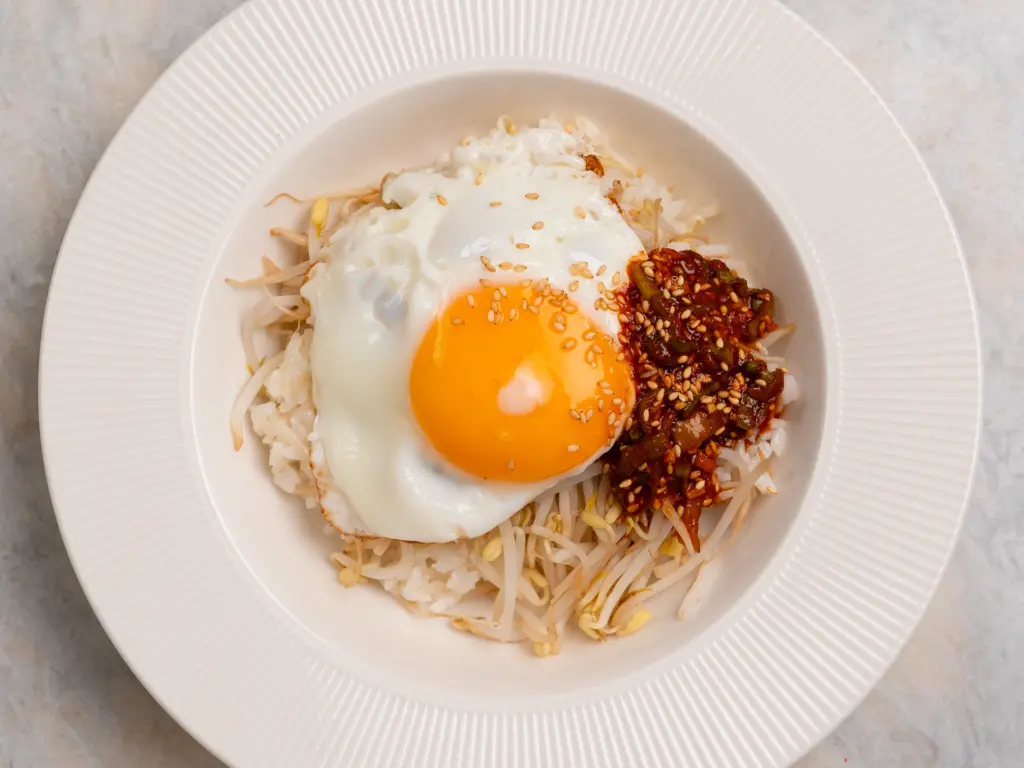
Microwave-Friendly Kongnamul Bibimbap in Just 5 Minutes
In today’s fast-paced world, especially in Korea where many people start their day early and return home late, finding time to cook can be challenging. Traditional cooking methods may not fit into tight schedules, leading many to rely on delivery services or ready-to-eat meal kits. However, there’s a quick and easy solution: microwave-friendly Kongnamul Bibimbap.
This kongnamul bibimbap recipe allows you to prepare a delicious and nutritious meal in just 5 minutes. To make kongnamul bap, you need macrowave-safe bowl. By layering rice and soybean sprouts in a microwave-safe bowl and heating them together, you can enjoy a hot meal without the need for extensive preparation or cooking time. Adding a fried egg on top enhances the dish’s protein content, making it a well-rounded option for any time of the day.
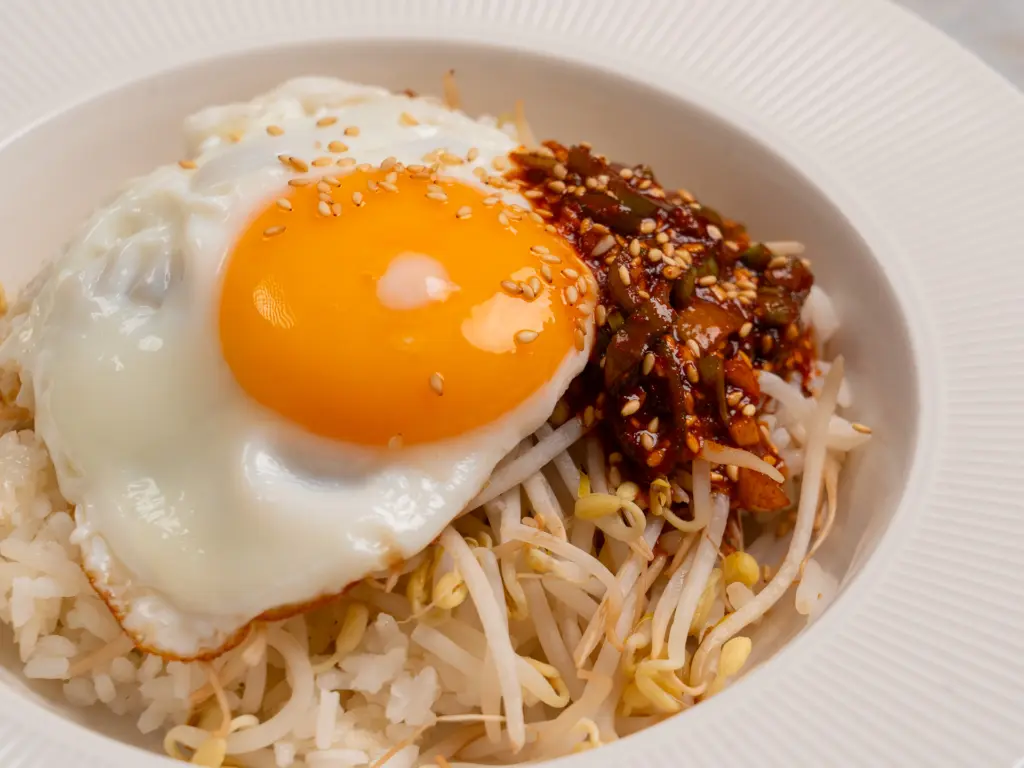
Ingredients for Bibimbap with Soybean Sprouts
Main Ingredients
- Rice
- Soybean sprouts
- Egg (optional)
Sauce & Seasoning
- Soy sauce base
- Plum extract
- Gochugaru (Korean chili flakes)
- Garlic
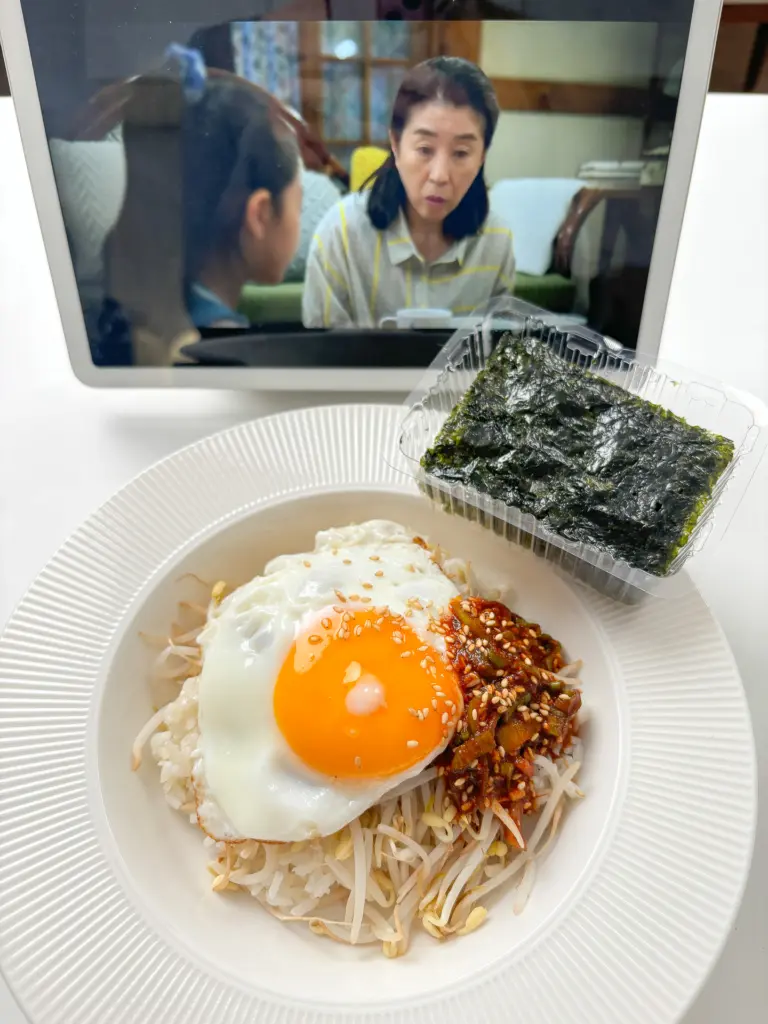
Optional Extras
This sprout bibimbap is already delicious when mixed and eaten as is, but wrapping it in seasoned roasted seaweed adds a salty crunch and enhances the aroma of sesame oil, taking the flavor to the next level. In Korean cuisine, achieving such balance and harmony is always key.
Substitutions
- Soybean Sprouts: In places where Korean soybean sprouts are hard to find, like in Europe, you can use mung bean sprouts (as shown in this recipe) and it will still taste great. Keep in mind that cooking times in the microwave may differ between soybean sprouts and mung bean sprouts, so follow the recipe instructions carefully.
- Plum Extract: Many Korean mothers use plum extract (maesil-cheong) instead of sugar. It’s considered healthier, adds a subtle acidity, and enriches the flavor of the dish. It also helps reduce fishy or meaty odors. Outside of Korea, plum extract can be hard to find; honey or sugar can be used as alternatives. While these substitutes provide sweetness, they won’t fully replicate the unique aroma and depth of flavor that plum extract offers. For an authentic taste of Korean home cooking, having plum extract on hand is highly recommended — it opens up a richer and more layered flavor experience.
- Korean Plum Syrup on Amazon
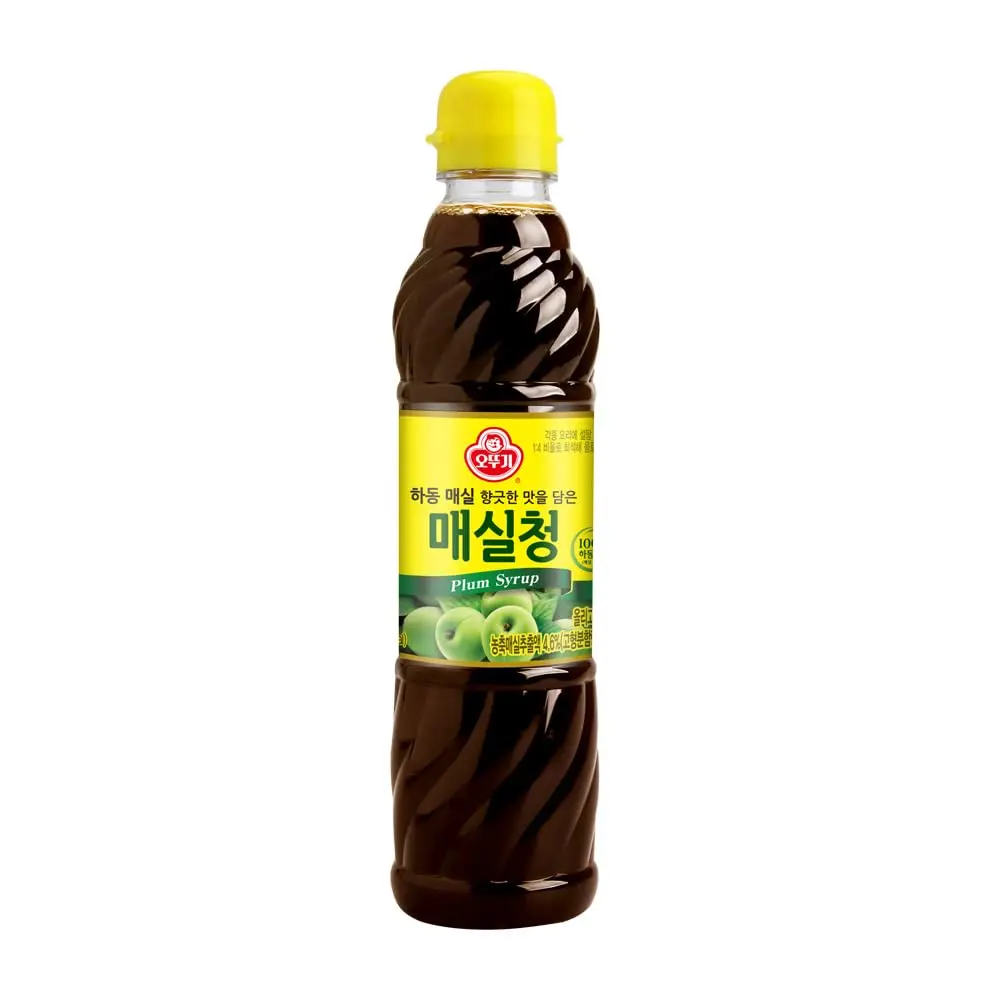
Kitchen Tools You’ll Need
Microwave-Safe Bowl
- Microwave Steam Bowl
Many Koreans use microwave steam bowls for recipes, and you may have seen them in cooking videos. While you can use a regular microwave-safe rice bowl, investing in a steam bowl allows you to cook various Korean vegetables and side dishes easily in the microwave, without boiling water or using a steamer. It makes preparing quick, healthy Korean meals much more convenient.
Frying Pan for the Egg
Using a stainless steel frying pan can dramatically improve the quality of your cooking. Stainless steel heats evenly, retains heat well, and allows you to achieve a perfect golden-fried egg with a slightly crispy edge. Unlike non-stick pans, it helps develop richer flavors and better textures, making even simple dishes like a fried egg taste more professional and delicious.

Step-by-Step Kongnamul Bibimbap Recipe
Step 1 – Steam Rice & Sprouts in the Microwave
Place rice and soybean sprouts in a microwave-safe bowl and cover with a plate or wrap, leaving a small vent for steam. This allows the sprouts to cook evenly.
- If you’re using Korean soybean sprouts, microwave for 5 minutes.
- If you’re in Europe or elsewhere and using mung bean sprouts, microwave for 3 minutes.
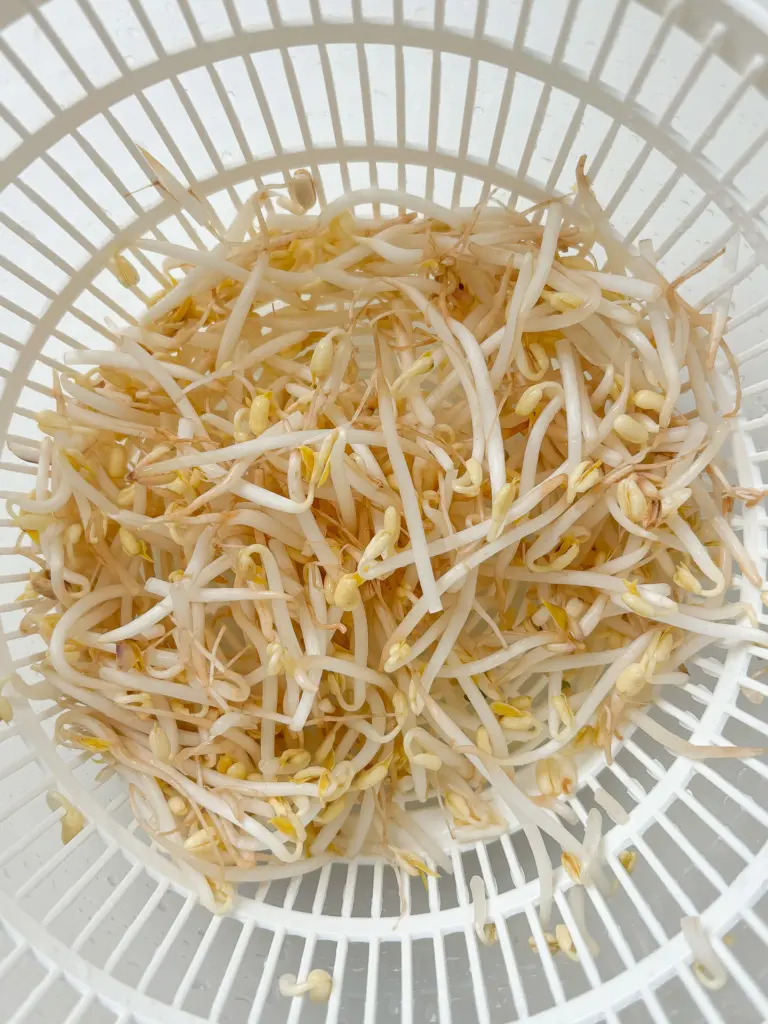
Tip: Mung bean sprouts are much thinner than Korean soybean sprouts. If your microwave is strong, check them at 2 minutes 30 seconds to see if they are cooked and not burnt. Adjust by microwaving for another 30 seconds if needed. In my case, I used mung bean sprouts and microwaved at 800W for a total of 3 minutes.
Step 2 – Mix the Bibimbap Yangnyeomjang (Sauce)
For Kongnamul Bibimbap, a soy sauce–based seasoning is traditional rather than gochujang.
- Soy sauce adds saltiness and depth.
- Plum extract adds sweetness, a fresh plum aroma, and subtle acidity.
- Add gochugaru (Korean chili flakes), minced garlic, and chopped green onion for a sharp, fragrant flavor.
- Finish with sesame oil and sesame seeds for nuttiness.
Mix all ingredients well to create a flavorful and umami-rich soy-based bibimbap sauce.
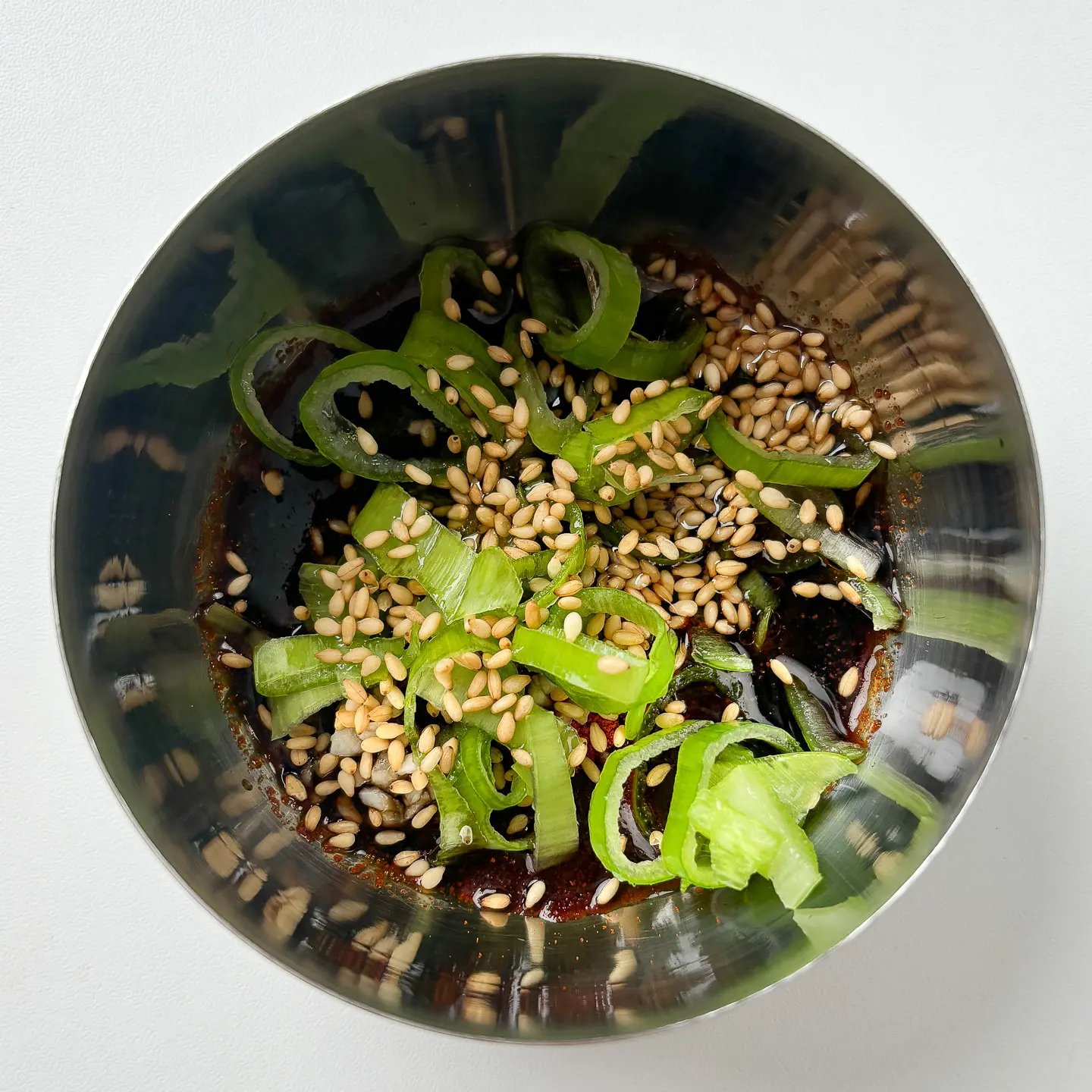
Step 3 – Cooking the Egg (Optional)
If you are vegan, you can skip the egg. Adding a fried egg enhances flavor, adds richness, and increases protein content for a balanced meal. Cook to your preference—soft yolk, medium, or fully cooked.
Step 4 – Assembling and Serving
Place the microwaved rice and soybean sprouts in a bowl. Top with the fried egg and pour the sauce over. Mix thoroughly before eating.

Pro Tip: For more delicious soybean sprout rice bowl, try wrapping portions in Korean roasted seaweed. The salty, nutty flavor of the seaweed combined with the kongnamul bibimbap creates an explosion of umami — it’s truly next-level. Many Koreans eat it this way, and you’ll quickly understand why!
Why You’ll Love This Beansprout Bibimbap
Quick Cooking (Just 5 Minutes!)
After a long day at work, some days you just don’t feel like cooking. Instead of grabbing unhealthy takeout, treat your body to a healthy meal that barely feels like cooking. Recipes like this Kongnamul Bibimbap are perfect — ready in just 5 minutes! In fact, I managed to make it in 3 minutes. Quick, simple, and nourishing.
Not Spicy
Even if you love bibimbap, some people can’t handle the spiciness of gochujang. Common Korean bibimbap sauces aren’t only gochujang based — they can also be made with soy sauce or doenjang (fermented soybean paste). Today’s recipe uses a soy-based sauce, making it milder. If you’re very sensitive to spice, you can even skip the gochugaru (Korean chili flakes). I’ve shared this with a friend in Belgium who can’t eat spicy food at all, and they loved it — so I’m confident you will too!
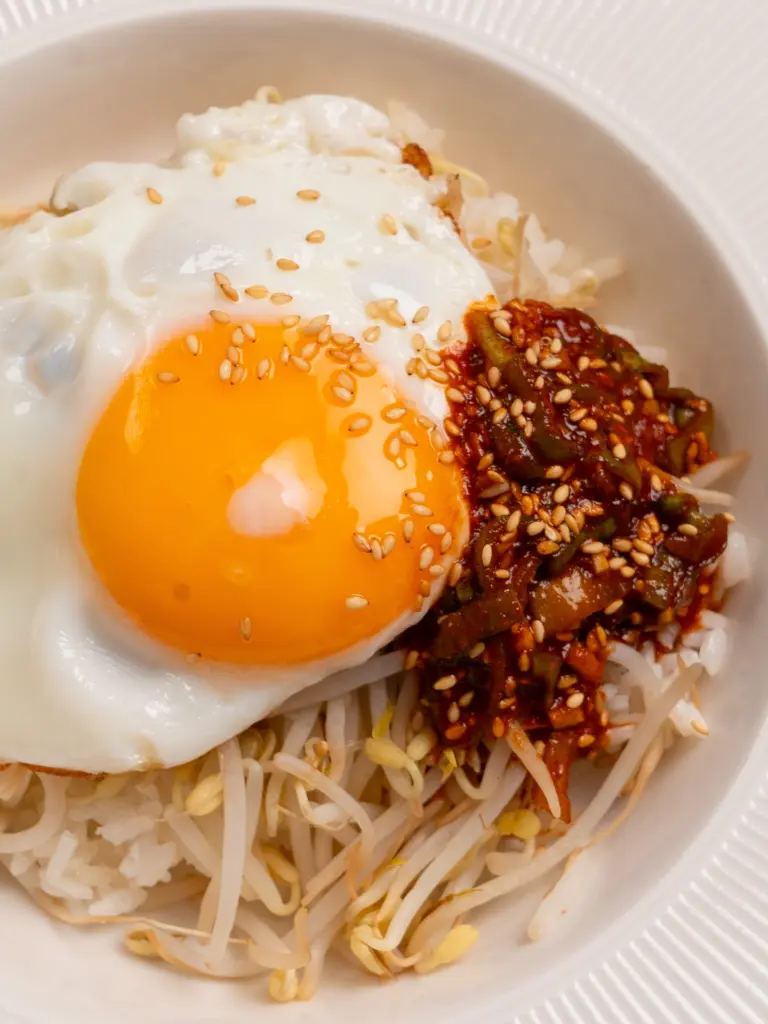
Minimal Ingredients, Maximum Flavor
Honestly, you could make this kongnamul bibimbap with just rice and soybean sprouts. It’s one of the simplest bibimbap recipes that still delivers incredible flavor. I highly recommend it for anyone looking for a minimalist yet delicious Korean meal.
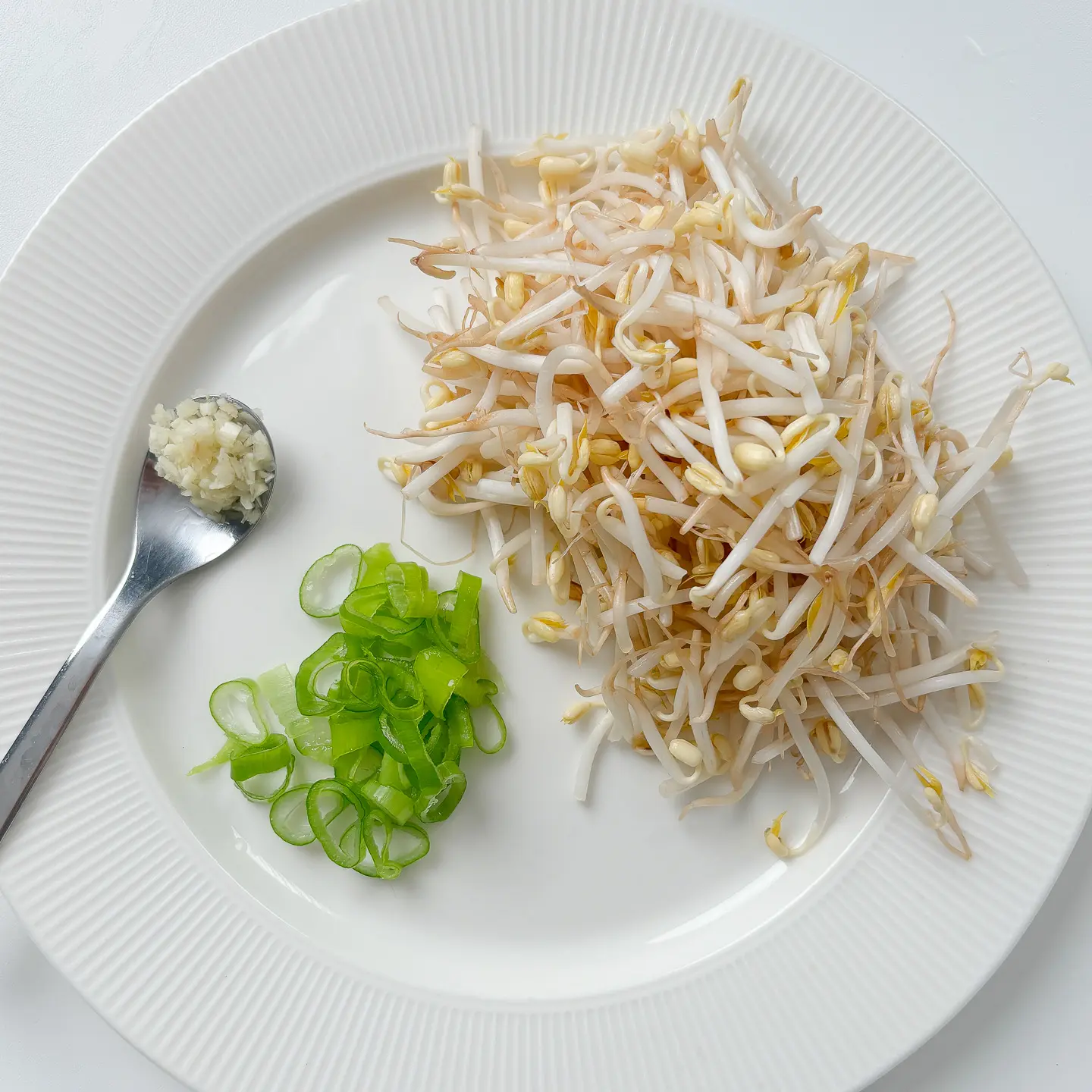
Pro Tips and Variations for Kongnamul Bibimbap
Mung Bean Sprouts Instead of Korean Soybean Sprouts
Korean soybean sprouts can be hard to find in Europe or other countries outside Korea. If you don’t live in Korea, mung bean sprouts are much easier to get, and they work perfectly for this recipe. I used mung bean sprouts today. They are thinner than Korean soybean sprouts, so they cook faster in the microwave, making this recipe even simpler and quicker.
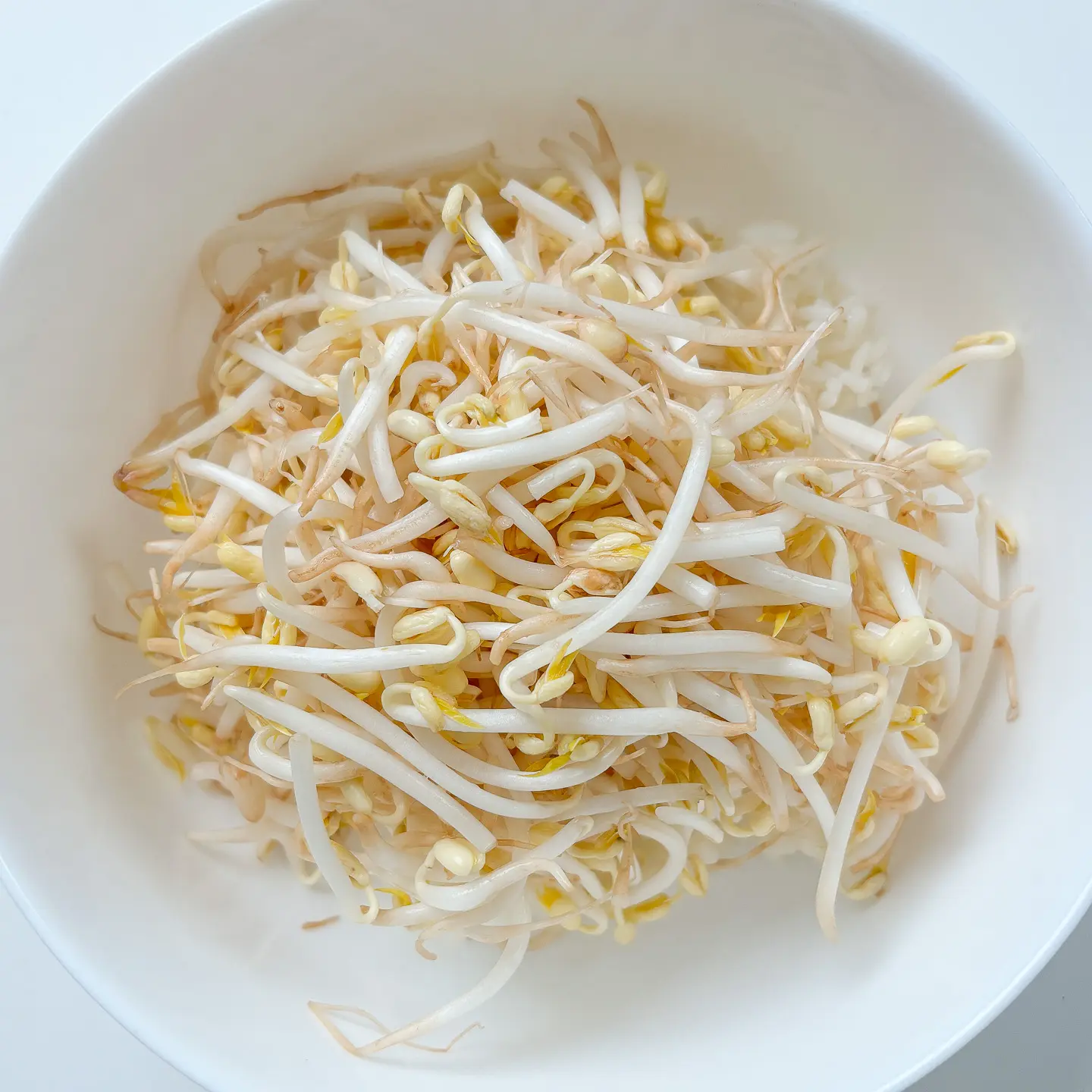
Wrap in Roasted Seaweed for Extra Flavor
This is how many Koreans enjoy Kongnamul Bibimbap — by wrapping it in seasoned roasted seaweed. The nutty, savory, and slightly crispy seaweed pairs perfectly with the crunchy, lightly salted sprouts, creating a unique mini-bibimbap roll. Once you try eating it this way, I apologize in advance — you might never go back to plain kongnamul bibimbap! The combination is just that irresistible.
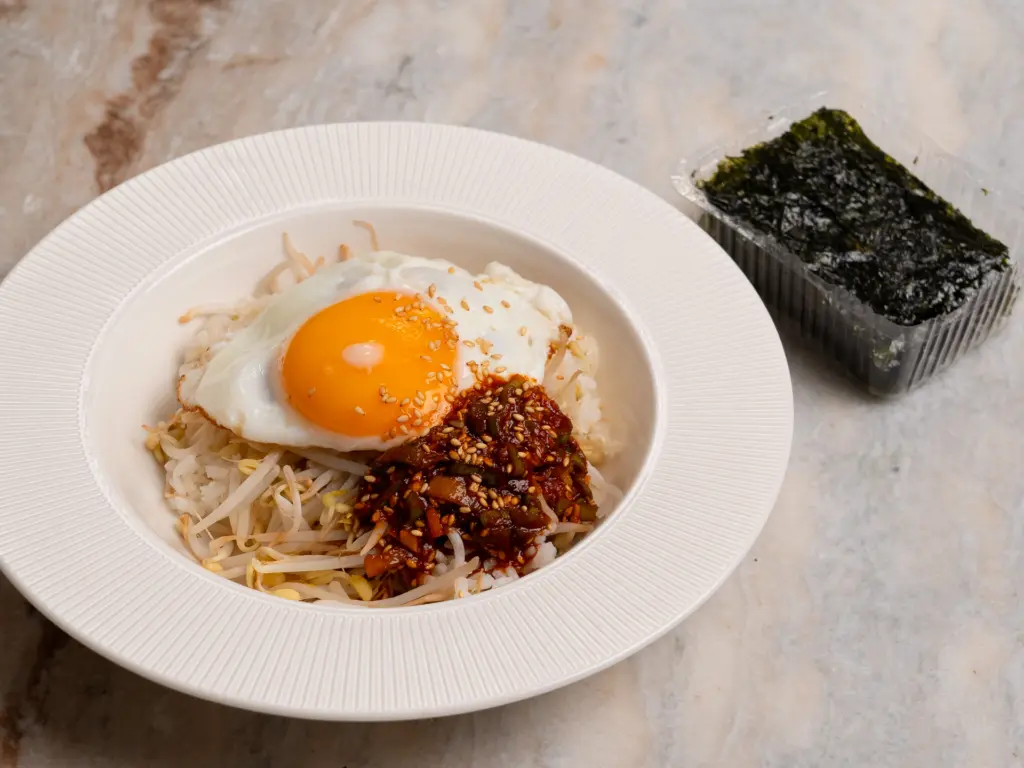
FAQs About Korean Kongnamul Bibimbap
What is Kongnamul Bibimbap?
Kongnamul Bibimbap is one of the simplest bibimbap dishes, made by placing soybean sprouts on rice, topping with a fried egg, and mixing in a soy-based sauce. In today’s recipe, I’ll show you the easiest way to make it anywhere in the world using a microwave. In just 5 minutes, you can enjoy a delicious Korean bibimbap.
Can I make Bibimbap in the microwave?
Absolutely! This kongnamul bibimbap recipe uses the microwave to steam rice and sprouts together. Even if you don’t have Korean soybean sprouts, mung bean sprouts work just as well, as shown in this recipe. They cook faster than traditional Korean soybean sprouts, which is actually a bonus for busy cooks.
What if I don’t have soybean sprouts?
If you don’t have Korean soybean sprouts, mung bean sprouts are a great substitute. They are thinner than soybean sprouts but still delicious. Keep in mind that cooking time is shorter, so follow the recipe instructions carefully.
Is bean sprout bibimbap spicy?
Not at all. Unlike other bibimbap varieties, Kongnamul Bibimbap is made with a soy-based sauce instead of gochujang (chili paste). Even those sensitive to spice can enjoy it. You can also use this soy-based sauce for other bibimbap dishes to make them milder and just as tasty.
Can I make bibimbap vegan or vegetarian?
Yes! This kongnamul bibimbap is already vegetarian. If you’re vegan, simply skip the fried egg. Many Koreans also prepare it without the egg, and it’s still delicious.
What’s the ideal way to serve Kongnamul Bibimbap?
Wrap it in roasted seasoned seaweed! The salty, nutty flavor of the seaweed combined with the crunchy soybean sprouts and savory rice creates an irresistible harmony. Once you try it this way, you might never go back to eating it plain.
Can I scale this recipe for two or more servings?
Of course! Simply adjust the ingredient amounts according to the recipe. You can scale it up to serve any number of people while maintaining the same taste and texture.

Kongnamul Bibimbap Ingredients on Amazon
- Rice Cooker that I use
- Silit Wok (Still Frying pan)
- Microwave Safe Steam Bowl
- Jin Ganjang (Korean Soy Sauce)
- Korean Plum Syrup
- Gochugaru
- Korean Sesame Oil
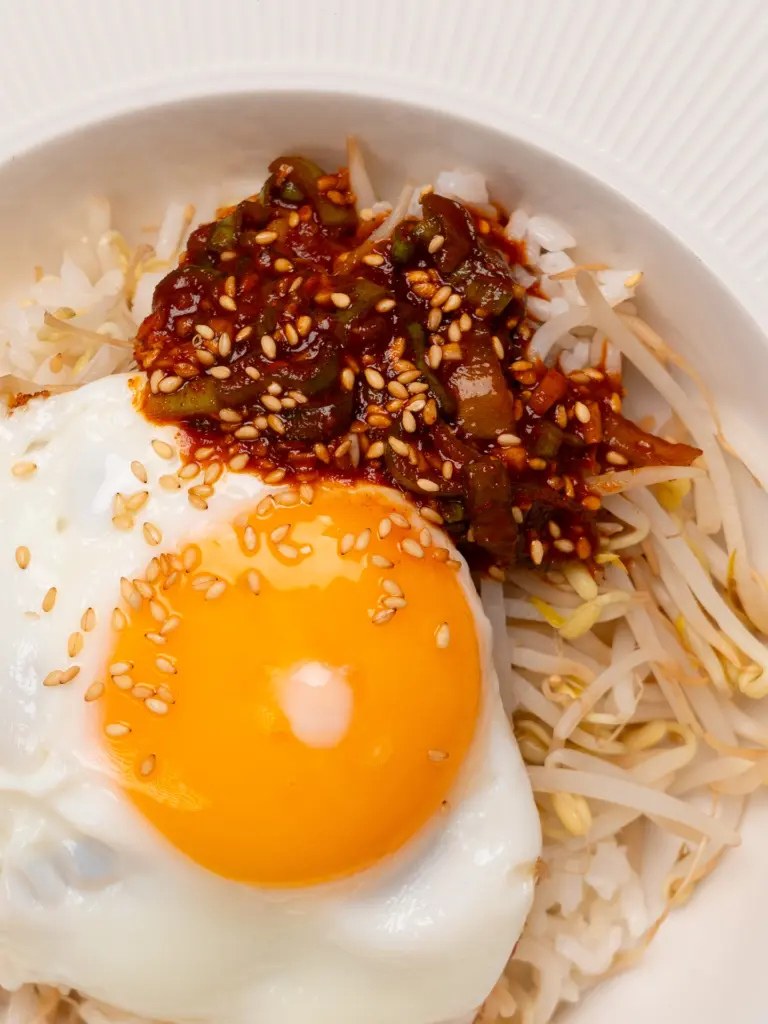
Other Bibimbap Menus
Dolsot Bibimbap
Dolsot Bibimbap is the most globally recognized type of bibimbap. It features colorful vegetables like carrots, spinach, and mushrooms, along with meat and a fried egg, topped with a sweet and spicy gochujang (Korean chili paste) sauce. Served in a hot stone bowl, it stays warm for longer, and the crispy rice crust at the bottom adds a delightful texture. This is the exact restaurant-style dolsot bibimbap recipe you’ve likely enjoyed before. My Belgian boyfriend even said it tastes better than what he had in Korea — that’s how authentic and delicious it is!
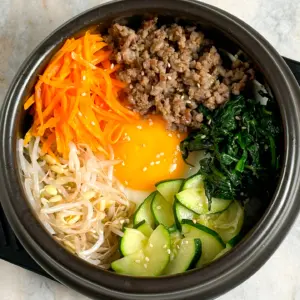
Musaengchae Bibimbap
Musaengchae Bibimbap is a simple home-style version that Koreans often prepare. Unlike the more elaborate restaurant-style bibimbap with multiple vegetables and meat, this version uses ingredients commonly found at home. It consists of crunchy, seasoned radish (musaengchae) placed over rice, mixed with sesame oil for flavor. Since it contains no meat, it’s a lighter, cleaner, and equally delicious bibimbap option — perfect for a quick and healthy meal at home.

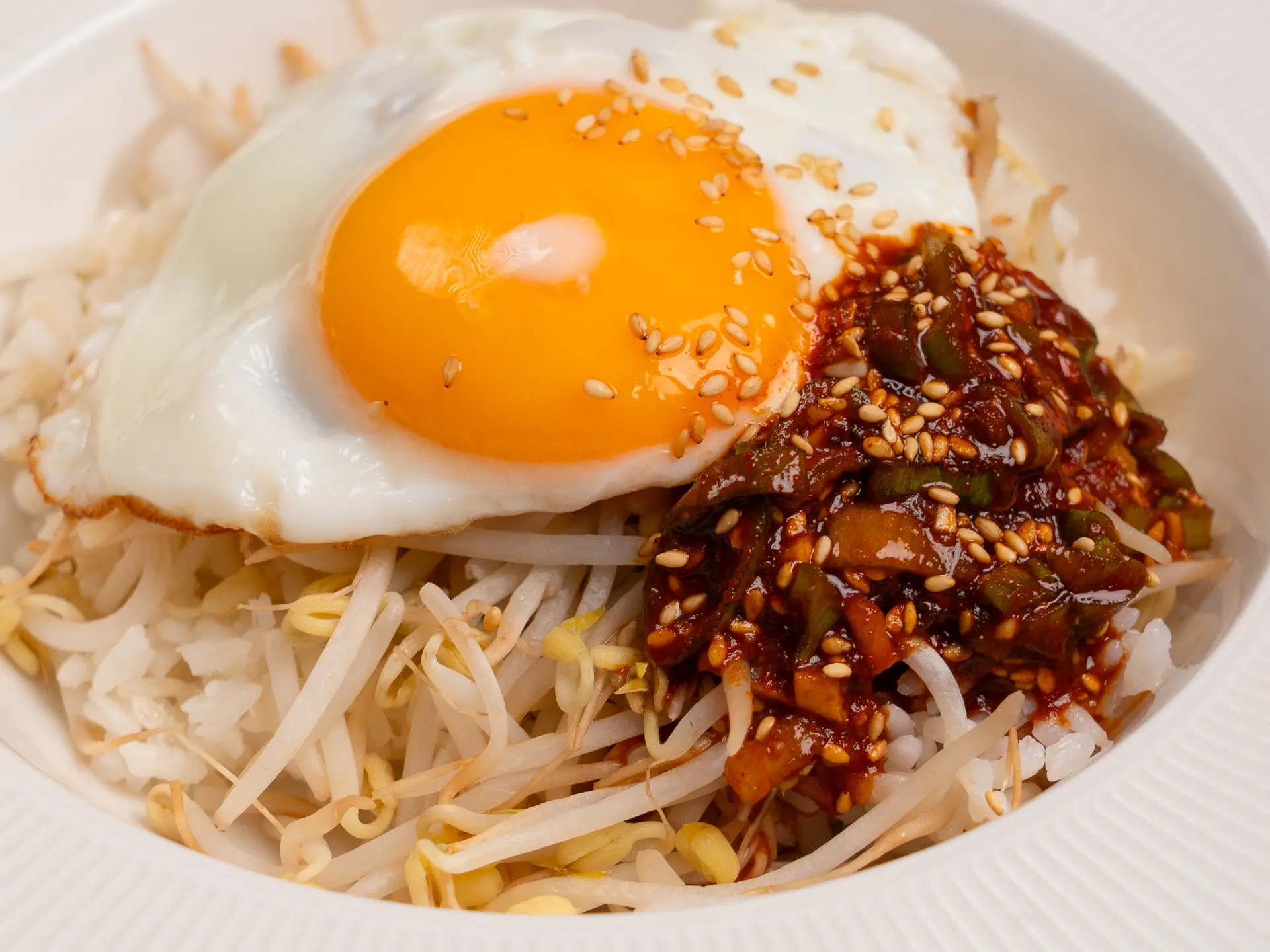
Kongnamul Bibimbap: Quick Microwave Bibimbap with Soybean Sprouts
Ingredients
- 100 g soybean sprouts (or mung bean sprouts)
- 1 bowl cooked rice
- 1 egg
- 2.5 tbsp soy sauce
- 0.5 tbsp plum syrup (you can skip, or honey or sugar as an alternative. If you use sugar, use way less than 0.5 tsp)
- 0.5 tbsp gochugaru (Korean chili flakes)
- 1/2 tsp minced garlic
- 1 tbsp sesame oil
- 1 tbsp chopped green onion
- 1/2 tbsp toasted sesame seeds
Equipment
- 1 smal bowl (for mixing the sauce)
- 1 Spoon
Method
- Put cooked rice and soybean sprouts in a microwave-safe bowl. Cover with plastic wrap and poke a few holes, or simply place a lid loosely on top.1 bowl cooked rice, 100 g soybean sprouts
- Microwave for 5 minutes if using soybean sprouts. If using mung bean sprouts, cook for 3 minutes, checking at 2 minutes 30 seconds to prevent burning.
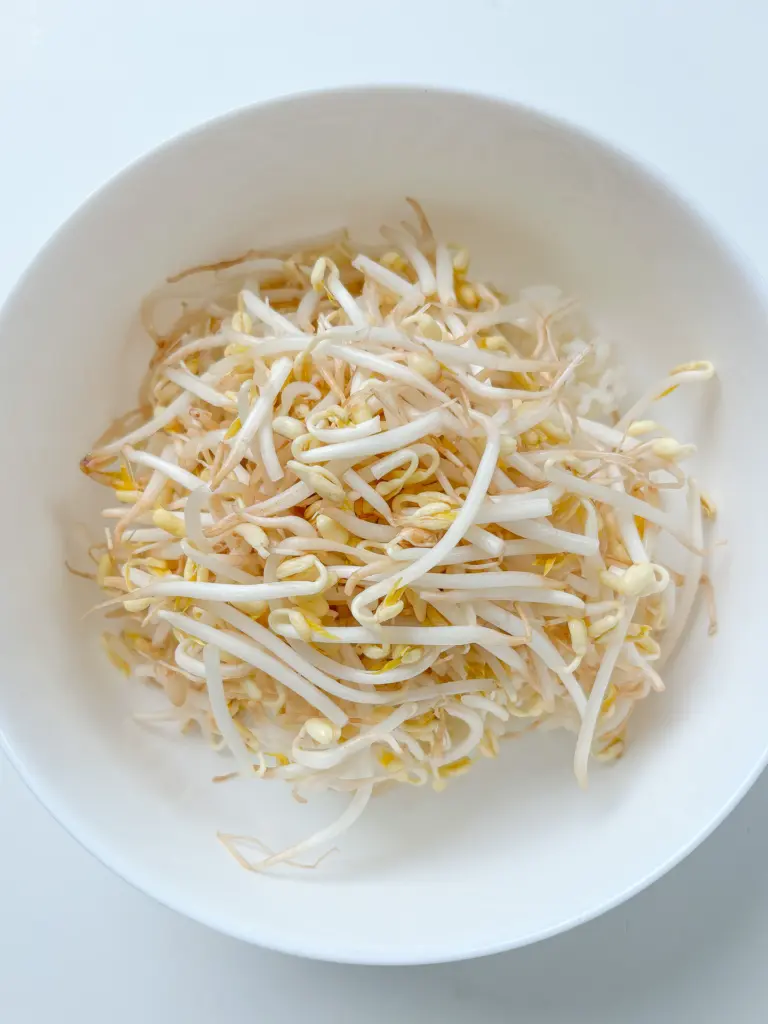
- In a small bowl, mix soy sauce, plum extract, gochugaru, minced garlic, sesame oil, chopped green onion, and sesame seeds to make a savory soy-based sauce.2.5 tbsp soy sauce, 0.5 tbsp plum syrup, 0.5 tbsp gochugaru, 1/2 tsp minced garlic, 1 tbsp sesame oil, 1 tbsp chopped green onion, 1/2 tbsp toasted sesame seeds
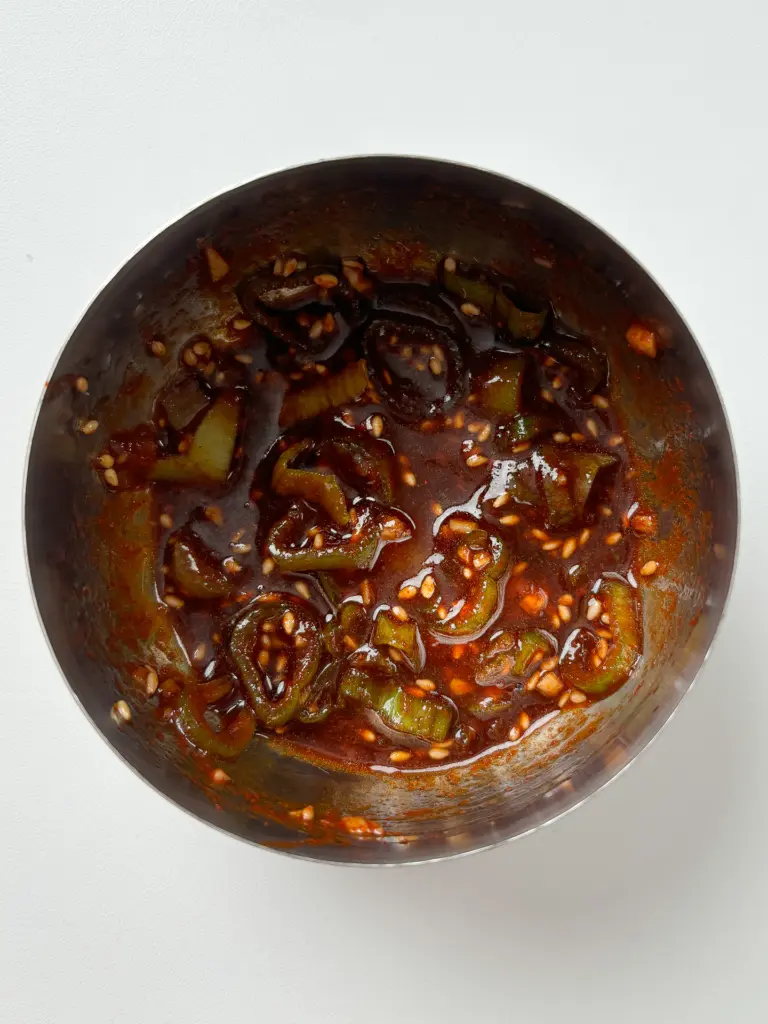
- Heat a bit of oil in a frying pan and fry the egg to your preference (sunny-side up works best).1 egg

- Place the fried egg and soy sauce mixture over the steamed sprout rice.
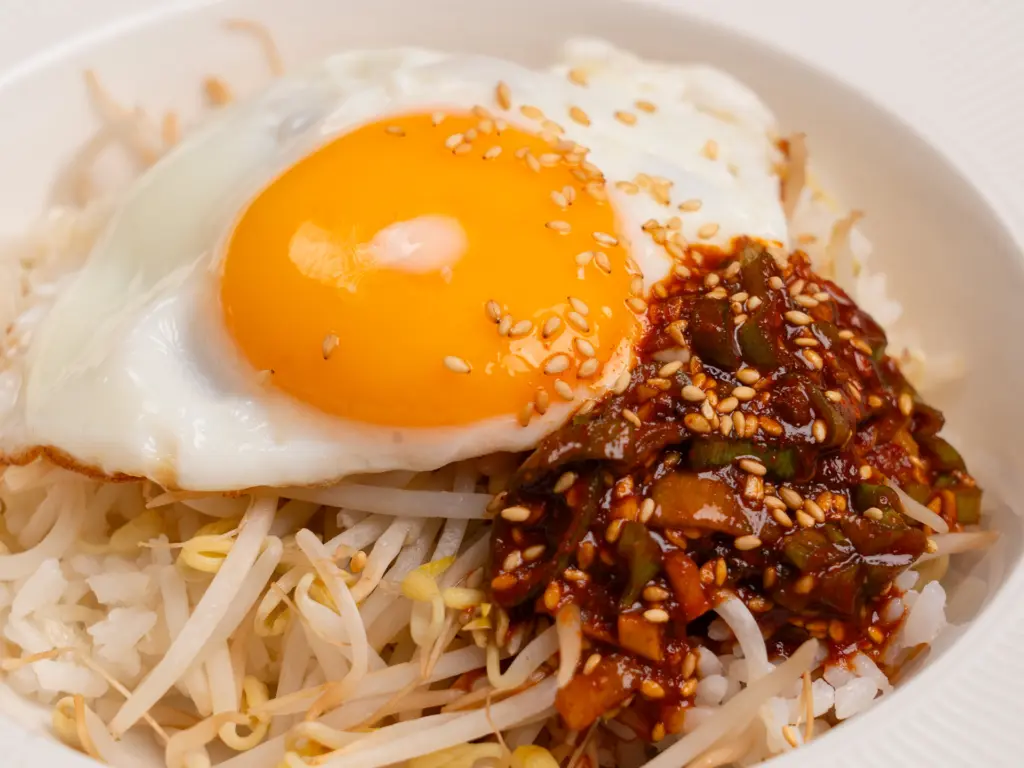
- Stir well and enjoy your delicious Soybean Sprout Bibimbap! (Wrap it with roasted seaweed for extra flavor!)

Nutrition
Nutritional information is an estimate. For personalized advice, consult a registered nutritionist.
Made this recipe?
I’d absolutely love to see your version! Tag @blondekimchi_ on Instagram and rate the recipe below to let me know how it turned out!Disclosure: Blonde Kimchi is part of the Amazon Services LLC Associates Program, an affiliate advertising program that allows websites to earn advertising fees by linking to Amazon.com and promoting products.
